This post may contain affiliate ads at no cost to you. See my disclosures for more information.
I have very fond memories of doing a feelings unit with my children when they were preschoolers. At the time we did several activities to introduce feelings, and I have continued to discuss feelings with them on a regular basis over the last few years.
Of course I hope my kids’ lives are mostly filled with happiness, joy, excitement, and other positive feelings. But I am also doing my best to equip them with the emotional resources they need to handle feelings of anger, disappointment, sadness, etc.
I truly believe that supporting children to deal with their feelings in an appropriate manner is one of the most important tasks that parents and teachers can undertake to benefit the children in their care.
Toward that end, I have put together a list of 45+ books about feelings for kids. These books cover feelings in general as well as specific feelings such as anger, grumpiness, fear, and worry.
Among this collection of children’s books about feelings, I hope you’ll find some helpful resources for the young children in your life.
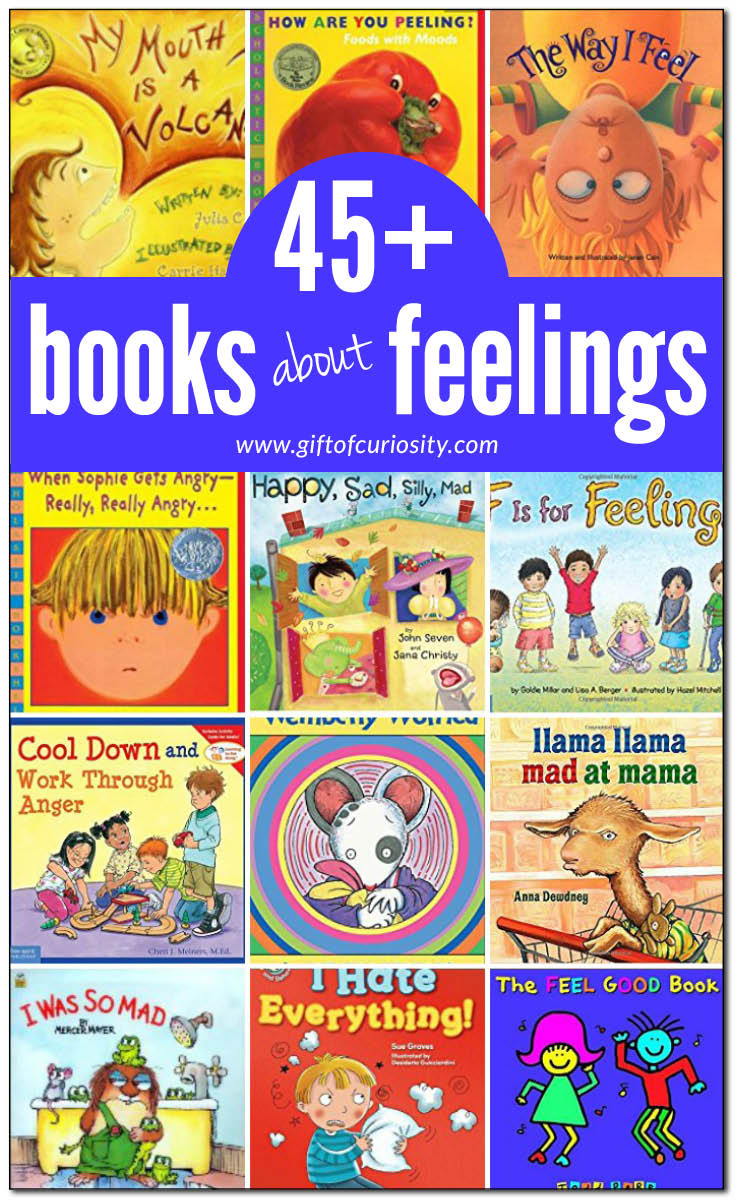
Books about feelings
How Does Baby Feel? by Karen Katz
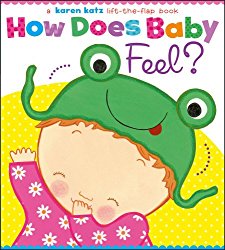
This is a great introductory book about feelings for babies and toddlers, but would probably bore most kids over the age of 3. Each page starts with a statement, such as “Baby gets a tummy tickle.” On the opposite page is a question: “How does baby feel?” Kids are then invited to lift the flap to discover baby’s emotion. Ages 1 to 3.
The Way I Feel by Janan Cain
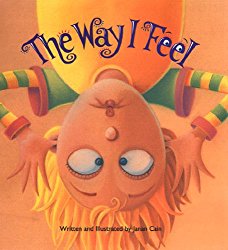
This book covers a wide range of emotions, from silly to disappointed to angry to shy. Each is featured on its own spread, accompanied by a short poem describing the feeling. The marvelous use of color and expression in the illustrations accurately captures the feeling being described. The back of the book includes a note to parents with several suggestions for extending children’s learning while reading this book. Ages 3 to 8.
Feelings by Aliki
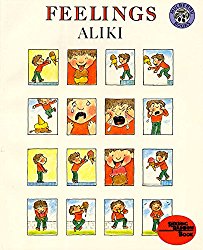
This book is quirky, but kids five and up might find it quite entertaining. It is quite different than most other books about feelings. Rather than one large illustration most pages have lots of small images that tell a multi-part story. Many pages also have a lot of text. Every page is quite different, but in general the book includes various scenarios like getting invited to party, building a block tower, having a block tower get knocked over, and being the new girl in class. For each scenario there is accompanying text between characters that shows how the characters feel about each situation. Ages 4 to 8.
How Are You Peeling? Foods with Moods by Saxton Freymann and Joost Elffers
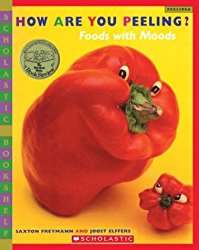
Children of all ages are sure to laugh out loud when reading this book featuring various foods made up to express a variety of emotions. The delightful and colorful photographs are accompanied by simple text. Much of the text takes the form of questions about how one would feel in various situations. In this way, the book is a fabulous jumping off point for sparking discussions with kids about their feelings. Ages 3 to 8.
Today I Feel Silly: And Other Moods That Make My Day by Jamie Lee Curtis
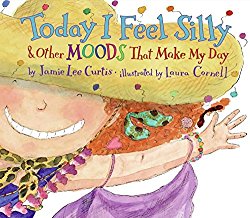
This book covers a lot of feelings, providing colorful illustrations and rhyming text to describe each feeling. Things to like about this book are the wide range of feelings discussed, from the basic ones like happy and sad to less commonly discussed ones such as silly, grumpy, confused, and lonely. Kids will also enjoy playing with the feelings wheel at the back of the book that allows them to spin a girl’s eyes and mouth to create different feelings. I also enjoy books with rhyming text. For me, however, there were two main drawbacks to the book. First, I found the illustrations to be distracting and unfocused. My eye wasn’t sure what the focus point on each page was supposed to be. I was also uncomfortable reading to my preschoolers the part where the little girl felt excited and admitted having a big crush on her teacher, but other parents may not share my concern about this part. Ages 3 to 8.
Lots of Feelings by Shelley Rotner
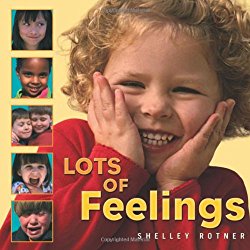
This is a very simple concept book for toddlers and preschoolers who are learning about feelings. Each page features photographs of real children who are happy, sad, exciting, scared, shy, proud, and more. Ages 3 to 6.
A Little Book About Feelings by Abbie Schiller
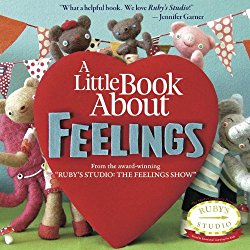
This sweet book helps kids understand where feelings come from and what to do about them. It explains that “Our brain sends messages to our bodies, making us feel different things. You can see feelings on faces and bodies. Or you can use words to express them.” The photo illustrations were created by putting stuffed animals into various situations and photographing them, with adorable effect. Ages 3 to 6.
Happy, Sad, Silly, Mad by John Seven
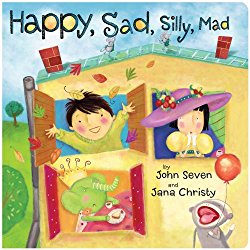
This book with bright, adorable illustrations shows young children in a variety of situations with text explaining how each situation makes them feel. For example, “The moon makes me curious” and “Leaves make me excited.” The last page is a picture of the children in their homes with the text, “Home makes me feel loved.” This sweet and simple book will show kids how different circumstances provoke lots of different emotions. Ages 1 to 4.
The Feelings Book by Todd Parr

This book is classic Todd Parr, with bright, bold, illustrations and a straight forward text with deep meaning. Each page features a character – who are mostly human, but also animal as well – sharing how they “sometimes” feel. This book helps kids know that their feelings are okay, whether they feel scared, like standing on their head, like reading a book under the covers, or like trying something new. Even if you don’t feel like doing anything at all, this message from this book is that it is okay to share your feelings with someone you love. Ages 2 to 7.
The Feel Good Book by Todd Parr
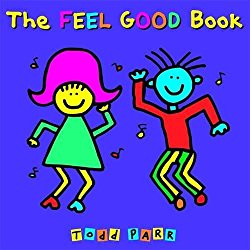
This book is all about things we can do that make us feel good. Giving big hugs feels good. Getting tickled feels good. Rubbing noses feels good. This book is filled with lots of ideas – some of which are quite silly! – about things that make you feel good. Ages 2 to 7.
Lizzy’s Ups and Downs: NOT An Ordinary School Day by Jessica Harper
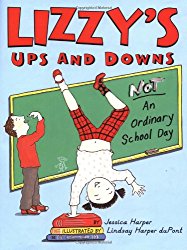
At the end of the school day, Lizzy lays on the couch and tells her mother about her day. As she recounts in detail everything that happened during the day, she tells her mother how she felt. She felt sad when her friend packed her stuff on her last day at the school. She felt annoyed when a classmate ate the jellybeans she was using to practice addition. She was glad when a boy in her class was sent to the principal’s office. She felt silly when playing a game of Twister. And she felt happy to be home at the end of the day. After telling her story, Lizzy asks her mom, “Does the whole world have ups and downs like mine?” Her mother assures her that her feelings are completely normal. Ages 3 to 7.
On Monday When It Rained by Cherryl Kachenmeister
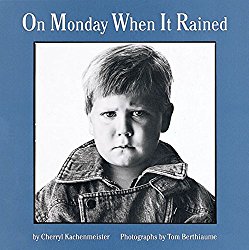
On Monday when it rained, the boy couldn’t play outside and he was. . . disappointed. So opens this book, which goes through each day of the week and shares something that happened. Young readers then turn the page to learn how the boy felt about it, and to see a photograph of his face showing the appropriate emotion. All photographs are in black and white, but they are quite expressive. The simple concept behind this book makes it a lovely tool for discussing emotions with kids. Ages 3 to 7.
This book uses some very colorful similes to describe the big feelings of one very expressive young girl. Her sadness is like a big, dark, rumbling storm cloud; her excitement is like a big balloon that is growing and growing until it might pop; her disappointment is like a flattened balloon that has lost all its air. Children will enjoy the vivid descriptions of a variety of feelings, and may enjoy adding some vivid descriptions of their own. Ages 5 to 9.
Double-Dip Feelings: Stories to Help Children Understand Emotions by Barbara S. Cain
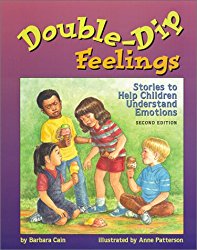
This book is all about showing the conflicting feelings we all feel at some times, such as feeling both proud and scared on the first day of school or feeling both joy and sadness at the arrival of a new sibling. After introducing each situation and telling how the character is feeling two conflicting emotions at the same time, the book asks “Do you ever feel both __ and __ at the same time?” This question provides a great opportunity for parents, caregivers, and teachers to discuss feelings with children. Ages 4 to 9.
Baby Happy Baby Sad by Leslie Patricelli
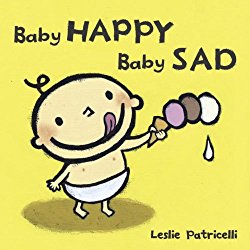
This is a great book for babies and toddlers to see different situations that make them feel happy or sad. For example, the baby feels happy when she hugs the cat, but sad when the cat runs away. The baby is happy when eating an ice cream, but sad when the ice cream falls to the ground. Each page features only the simple text “Baby happy, baby sad,” but this book would provide a great opportunity to show babies how various situations can affect our feelings. Ages 2 to 4.
F Is for Feelings by Goldie Millar
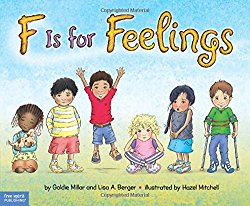
This is an ABC book that discusses one feeling for every letter of the alphabet. A is for afraid, and shows an illustration of a child who is scared. B is for brave, showing a little girl facing her fear of the dark. C is for confused, and shows a boy puzzling through a tangrams problem. The illustrations include a diverse group of kids from different racial and ethnic backgrounds and different religions. Ages 3 to 8.
The Great Big Book of Feelings by Mary Hoffman
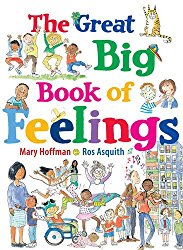
This book features an emotion on each page along with several ideas for things that might make a person feel that emotion. For example, you might feel happy when you cuddle your pet or read your favorite book. You might feel sad when it rains or someone forgets your birthday. And you might feel excited to go on an outing or climb a tall mountain. This book covers a wide range of emotions that include confident, silly, worried, jealous, and satisfied, among others. Each page features a variety of illustrations, some of which will make children laugh. I like that the book features a diverse cast of characters from different racial and ethnic backgrounds, kids wearing religious clothing, and kids with different abilities. Ages 4 to 8.
My Many Colored Days by Dr. Seuss
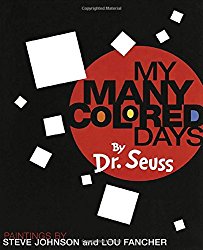
This delightful Dr. Seuss book uses the metaphor of color to help describe different feelings, each of which is also linked to an animal. Therefore, some days are bright red, and it feels good to be a horse kicking its heels. Other days are brown, and you feel like a slow bear who just wants to lay down. Some days are yellow, and you feel like a busy, buzzy bee. Ages 3 to 7.
Happy Hippo, Angry Duck: A Book of Moods by Sandra Boynton
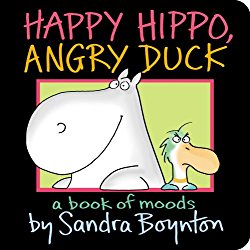
This book is written in Sandra Boynton’s classic rhyming, silly style with funny illustrations that young children will enjoy. This book asks young readers “Are you happy as a hippo? Or angry as a duck? Maybe sad as a chicken? Can you sadly say ‘cluck cluck’?” The book continues in this style, and at the end it shares a message that there’s no need to worry if you are in a bad mood, because everyone’s moods change day to day. Ages 2 to 6.
Glad Monster, Sad Monster by Ed Emberley and Anne Miranda
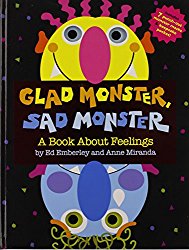
This adorable concept book will have kids laughing and smiling. The book includes brightly colored monster masks that correspond to each feeling being discussed. After hearing what makes the monster feel happy, sad, silly, worried, angry, etc., young readers are invited to pull out the corresponding monster masks, put them on, and say what makes them feel the same way as the monster. The back of the book includes a place to store all the monster masks for repeated use. Ages 3 to 7.
Books about feeling angry or mad
When Sophie Gets Angry–Really, Really Angry… by Molly Bang
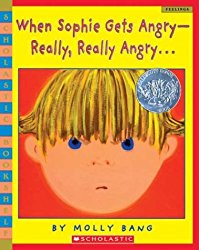
One day, Sophie’s sister grabs Sophie’s toy. Then, Sophie trips and falls over. Boy does Sophie feel angry when this happens! She feels like kicking, screaming, and smashing the world to smithereens. She runs to a safe place, has a good cry, and then calms herself down. Once she feels better, she goes back and re-joins her family.
This books provides a great opening for discussing anger with kids. It provides rich descriptions of what it feels like to be angry and includes illustrations to match. But most importantly, this story shows the calming down process. Further, it lets kids know that once they feel calm again, they are safe to rejoin their family and will still be loved. Ages 4 to 8.
When I Feel Angry by Cornelia Maude Spelman
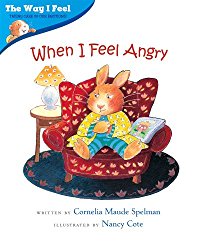
The lesson in this book is that while we all feel angry sometimes – and that is okay – it’s not okay to act in angry ways that hurt others. In this book we follow a young rabbit who feels angry when someone makes fun of her, she has to stop playing to clean up her room, or she can’t get her drawing quite right. When she feels angry, she wants to say mean things, yell, or hit others. But even though she feels that way, she doesn’t act on those behaviors because she doesn’t want to hurt others. The little rabbit shares several tools she uses to calm down when she feels angry so that she won’t act in an angry way that will hurt those around her. Ages 4 to 8.
Llama Llama Mad at Mama by Anna Dewdney
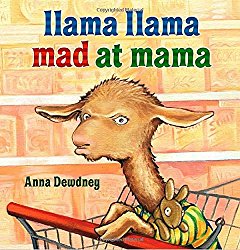
Llama is having fun at home when Mama decides it is time to go shopping. So Llama accompanies Mama to several stores, getting progressively more bored and fed up along the way, until finally Llama feels mad. Llama throws things out of the grocery cart, crashing the cart and smashing signs. Fortunately, Mama is there to address Llama’s feelings and behavior. This book, a follow up to Llama Llama Red Pajama, uses the same colorful illustrations and rhyming text. Many young readers will identify with the boredom and frustration Llama feels at having to run errands with Mama all day, but fortunately Mama has a solution that works for both of them. Ages 2 to 6.
I Hate Everything!: A Book about Feeling Angry by Sue Graves
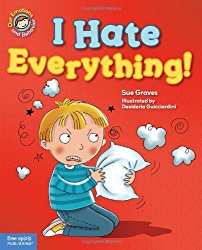
Sam is in a grumpy mood. He couldn’t sleep the night before because his brother was crying. He hated that. He wanted to play with his dad, but his dad was busy. That made him feel mad. His dad served him carrots for lunch, which Sam didn’t like. That made Sam very angry. On and on, every little thing seemed to be getting on Sam’s nerves, until he even ruined a friend’s birthday party by yelling “I hate everything!” Fortunately, his Aunt Meg is there to teach him some techniques for calming down. She shows him how to take a deep breath and count to 10. Sam starts to feel better. Then Aunt Meg helps Sam think of other things he can do when he feels mad, and he comes up with quite a list. Eventually, Sam calms down and apologizes to his friends. And now he has tools to draw upon to help him calm down the next time he feels so mad. Ages 4 to 8.
Finn Throws a Fit! by David Elliott
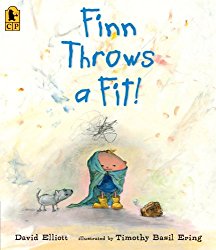
Finn is having a bad day. He usually loves peaches, but today he doesn’t like the peaches his mother is offering him. Today he doesn’t like anything. Finn is cranky. He feels like thunder and lightening. Eventually, Finn throws a fit. The house floods with his tears. An avalanche comes through when he screams. His kicks create an earthquake that shakes the world. The fit goes on and on. Until finally it ends. Things calm down, and Finn finally wants the peaches his mother is offering. Young readers will enjoy the dramatic descriptions of little Finn’s fit and the accompanying illustrations as well. Ages 3 to 7.
I Was So Mad by Mercer Mayer
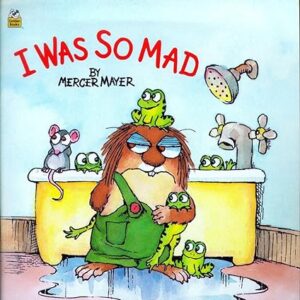
Little Critter wants to do lots of different things, but each time someone is there to say, “No, you can’t.” And each time, Little Critter feels mad. Eventually, he is so mad that he decides to run away. He packs his things and heads out the door, where he runs into his friends. They invite him to play, and his mom says he can. And suddenly Little Critter isn’t so mad anymore. This book will resonate with kids who are used to hearing “no” a lot. Ages 3 to 7.
Mouse Was Mad by Linda Urban
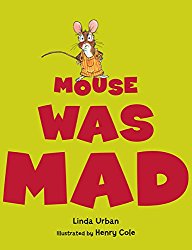
One day, Mouse was feeling hopping mad, and he hopped around to show it. Then Hare came by, and tried to show Mouse the proper way to hop. Mouse tried, but he wasn’t as good as Hare. That just made him stomping mad. Bear saw Mouse stomping his feet, and thought Mouse wasn’t doing it right. So Bear showed Mouse the right way to stomp. But Mouse couldn’t make the trees shake like Bear. On and on this went, until Mouse was so mad he was standing-still mad. The other animals watched with admiration while Mouse stood completely still. None of them could stand as still as Mouse! And eventually, Mouse stayed still so long that he realized he was no longer mad! Ages 4 to 7.
My Mouth Is a Volcano! by Julia Cook
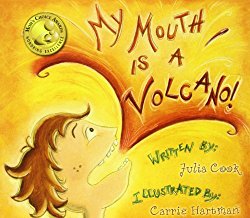
Louis is a boy who has a lot to say. Sometimes words pop into his head, and his tummy starts to rumble, and then it starts to grumble, and then his words begin to wiggle and jiggle and eventually they explode from his mouth like a volcano. Unfortunately for Louis, his volcano of a mouth gets him into trouble sometimes because he is constantly interrupting other people. One day Louis is giving a presentation to his class. During the presentation, two other students interrupt him, and he feels upset. But he learns from this experience what it’s like to be interrupted, and his mom helps him develop strategies to control his volcano of a mouth so that he doesn’t interrupt other people anymore. Ages 5 to 8.
Cool Down and Work Through Anger by Cheri J. Meiners
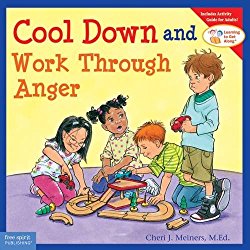
The message behind this book is that it’s okay to feel angry, and that there are helpful ways to deal with anger that won’t hurt or upset others. The back of this book includes resources for parents and caregivers to help children learn to deal with their anger productively, as well as games and activities for resolving anger. Ages 4 to 9.
I Am So Angry, I Could Scream: Helping Children Deal with Anger by Laura Fox
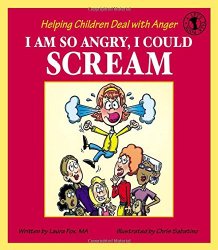
Penny is having a very rough day. By the time she gets home from school and her mom tells her she can’t go to a party on the weekend, she is feeling very, very angry. But fortunately her aunt has some helpful suggestions to help her channel her anger to something more productive. With her aunt’s help, Penny makes an “Anger Chart” listing all of the things that made her angry, why they made her angry, and how she could use her anger in positive ways. Ages 4 to 8.
Sometimes I’m Bombaloo by Rachel Vail
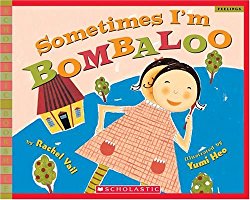
Katie Honors is a young girl who is normally very well behaved. She gives hugs, brushes her teeth without too many reminders, puts her toys away, and is patient with her baby brother. But sometimes she is bombaloo! In this book, bombaloo is used to describe the feelings and behavior that go along with out-of-control anger, when your face scrunches tight, you uses fists instead of words and you hate everybody and everything. For kids, it can be scary to feel bombaloo, and this book helps them to recognize and name their out-of-control behavior. Ages 4 to 8.
Books about feeling upset
Calm-Down Time by Elizabeth Verdick
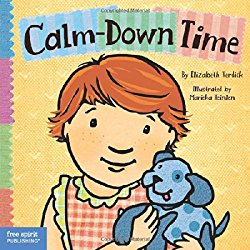
This is a wonderful book to share with toddlers and preschoolers who need help regulating their emotions when they feel sad or angry. The book, in very simple language, provides useful ideas for helping young children calm themselves when they feel negative emotions. Ages 1 to 3.
When Sophie’s Feelings Are Really, Really Hurt by Molly Bang
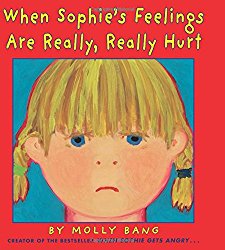
This is a follow up book to the popular book “When Sophie Gets Angry–Really, Really Angry…” by the same author. In this book, Sophie’s class is painting trees. Sophie loves trees and paints a beautiful work of art to show her love for trees, but her classmates make fun of her painting. This makes her feel really sad. Her teacher, however, handles the situation beautifully, which allows Sophie to feel proud of her work once again. Ages 4 to 8.
Mean Soup by Betsy Everitt
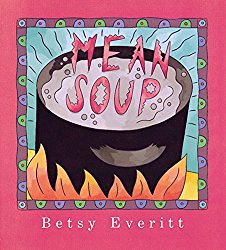
This sweet book shares the funny way a mom helps her son cope at the end of a very bad day. “Let’s make soup!” Horace’s mother announces, upon noticing how upset her son is. So his mother places a pot of water on the stove and puts in some salt. Then, she takes a breath and screams into the pot! “Your turn,” she tells Horace, and he follows her example by screaming into the pot of water. Horace and his mom take turns screaming into the pot of water. Once Horace feels better, he asks his mom what recipe they are making. “Mean Soup,” she replies. Ages 3 to 8.
Books about feeling grumpy
The Grumpy Morning by Pamela Duncan Edwards
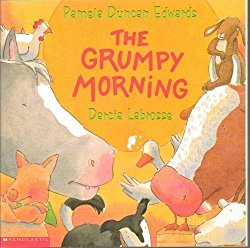
It is a very grumpy morning indeed for the animals when the farmer forgets to wake up one day. The cow begs to be milked, the cat wants to cuddle, and all the other animals are hungry and ready to eat! Eventually the grumpy animals band together to wake up the sleepy farmer, and all ends well. Ages 3 to 7.
The Three Grumpies by Tamra Wight
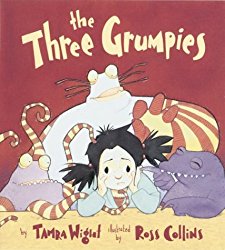
Some days kids just wake up on the wrong side of the bed, feeling grumpy all day long. In this book, a girl’s grumpy feeling is personified by three creatures she names Grumpy, Grumpier, and Grumpiest. Grumpy spills her milk at breakfast. Grumpier squeezed her toothpaste all over things. And Grumpiest hid her shoes. The girl tries to get rid of the Grumpies, but they just smile at her. Then the follow her to school, where they continue to wreak havoc on her day. And they follow her back home again. Eventually the Grumpies decide they’ve had enough, and they leave. But who will the Grumpies target next? Ages 3 to 7.
Alexander and the Terrible, Horrible, No Good, Very Bad Day by Judith Viorst
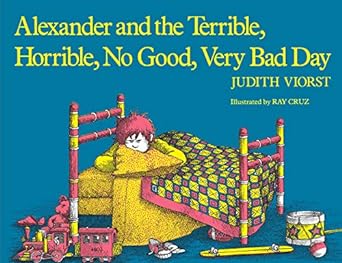
It seems that everything that can go wrong for Alexander is going wrong, and he is not feeling good about it. In fact, he’s downright grumpy! He wakes up with gum in his hair, trips over his skateboard, and then at breakfast everyone finds something cool in their cereal except for him. Then his best friend deserts him and he ends up squished in the middle seat of the car. Can the day get any worse? This book helps young children recognize that we all have bad days sometimes when even the smallest things seem to make us grumpy. Ages 5 to 9.
The Grouchy Ladybug by Eric Carle
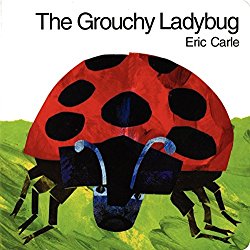
This story begins early in the morning, when two ladybugs are both eyeing the same aphids for their morning breakfast. One ladybug is kind, and she offers to share. But the other ladybug is grouchy, and she wants the aphids all to herself. The grouchy ladybug challenges the the kind ladybug to a fight. When the kind ladybug accepts the challenge, the grouchy ladybug complains, “Oh, you’re not big enough” and flies off. Each turn of the page shows a clock marking the passage of time, and each hour the grouchy ladybug challenges a new animal to a fight. But when each accepts her challenge, she continues to insist the animal is not big enough and flies off. At the very end of the day, the grouchy ladybug ends up back at the same leaf, feeling contrite and appreciative, and finally willing to share. Ages 3 to 7.
The Grumpy Day by Miriam Moss
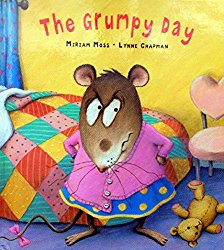
Smudge is having a very bad morning. She stubs her toe when she gets out of bed. Then she sees it is raining outside. When Stripe asks her a simple question, Smudge answers in a rude way, then declares she is leaving and never coming back. Outside, Smudge runs into Goose, who invites her to play. Soon, Smudge is having such a good time that she forgets to be grumpy and miserable. As night approaches, Goose encourages Smudge to go home, but Smudge says she can’t. So her friend offers to let her stay in a treehouse for the night. Alone in the treehouse, Smudge hears a noise and gets scared. Then her friend Stripe appears with supper! Smudge apologizes for her grumpy behavior during the morning, and the two friends eat supper and head home together. Ages 3 to 7.
The Pout-Pout Fish by Deborah Diesen
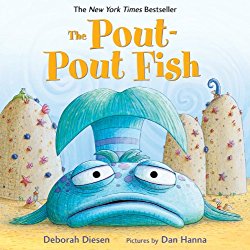
Deep in the ocean lives a fish with an ever present frown he calls his pout-pout face. One sea animal after another comes up to him and encourages him to smile, but the pout-pout fish says he was just born with a pout-pout face and there’s nothing he can do about it. “I spread dreary-wearies all over the place,” says the fish. After a while, the pout-pout fish lays upside down on a rock. This makes his usual frown look like a smile. Along comes a silver fish. But instead of talking to pout-pout fish, she plants a big kiss on his pout! From then on, the pout-pout fish decides that he is a kiss-kiss fish who spreads cheery-cheeries all over the place. Ages 3 to 7.
Books about feeling scared
The Invisible String by Patrice Karst
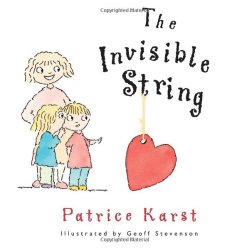
This is a beautiful book for reassuring kids who sometimes feel scared or lonely when they are not with their loved ones. In this story, a mom reassures her twins that there is an invisible string that connects us to everyone we love. Even when we can’t see the others, we can feel the string that connects their heart to ours, and we know that we are not alone. Ages 3+.
The I’M NOT SCARED Book by Todd Parr
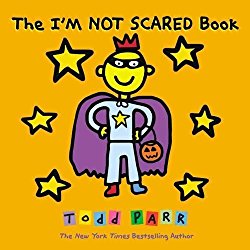
Todd Parr’s direct text and bright, simple illustrations combine for a wonderful book that teaches kids that it is okay to be scared, but it’s even better to confront those fears head on. Each page goes back and forth, with one page sharing “Sometimes I’m scared of. . . ” and the next page offering the antidote with “I’m not scared when. . .” For example, “Sometimes I’m scared of dogs,” is followed by “I’m not scared when they give me kisses.” And “Sometimes I’m scared of monsters and ghosts,” is followed by “I’m not scared when I see that they aren’t real.” Each spread focuses on genuine fears common to many kids. In this way, many kids will see their fears reflected in the story. Ages 2 to 7.
Books about feeling worried
When I Feel Worried by Cornelia Maude Spelman
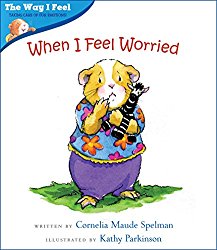
This book is part the of “The Way I Feel” series that includes several other titles. This book is an excellent way to open a discussion about worries and fears with kids. The story is told from the perspective of a little animal (perhaps a guinea pig?). It first discusses common things that would make a child feel worried, such as when he or she is trying something new or when others are fighting and yelling. It then goes on to describe the physical manifestations of worry, such as feeling weak and wobbly or having an upset tummy. The book also shares several ideas for what kids can do if they feel worried, such as talking to someone about it, getting a hug, or listening to music. Finally, the book reassures kids that worry is normal but doesn’t last forever. Ages 3 to 7.
Wemberly Worried by Kevin Henkes

Wemberly is a young mouse who worries about everything. She worries about big things, little things, and things in between. She worries no one will come to her birthday party. She worries about her doll, Petal. She worries about the noises made by the radiator. And she’s very worried about the start of school. But the first day goes better than expected, as Wemberly makes a friend and they get to play together. At the end of the day, her teacher tells Wemberly to come back tomorrow. And Wemberly responds, “Don’t worry, I will.” Ages 3 to 7.
Other books about feelings
I Just Don’t Like the Sound of No! My Story About Accepting No for an Answer and Disagreeing the Right Way! by Julia Cook
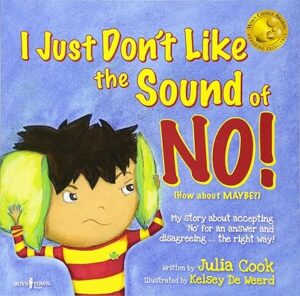
When RJ asks his dad to buy a box of markers, his dad says “no.” When he asks his mom if a friend can spend the night, she says “no.” RJ decides that he really does not like the word “no.” In fact, he tries to negotiate with his parents to get a better answer. But they still say “no.” His teacher tells RJ he needs to learn to accept no, and she gives him some helpful tips for accepting no and disagreeing respectfully with others. The back of the book includes helpful tips for parents and educators who are supporting young children learning to accept “no” for an answer. Ages 4 to 8.
I’m Sorry by Sam McBratney
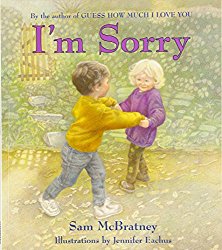
This book helps kids understand that sometimes we all get really upset with others, even the friends we love the most. In this story, a boy and his best friend get angry, shout at each other, and then refuse to play together. They pretend the other doesn’t exist. But in reality, they feel sad. They realize they need to say sorry, and when they do all is right with their friendship again. This sweet tale of young friendship teaches kids the importance of learning to say “I’m sorry.” Ages 4 to 8.

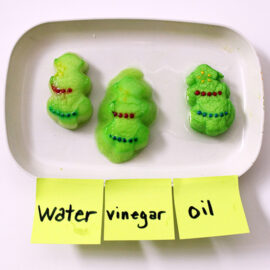
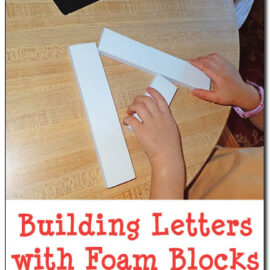

What a great list! And thank you for including The Pout-Pout Fish!
Best Fishes,
Debbie Diesen